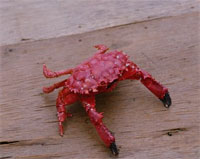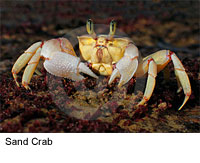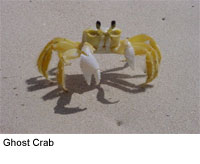|
The term crab is often applied to several different
groups of short (nose to tail) crustaceans with thick exoskeletons,
but only members of the Brachyura are true crabs. Others, such as
hermit crabs, porcelain crabs and king crabs are, despite superficial
similarities, not crabs at all; they can be distinguished from true
crabs by counting the legs (Uninjured true crabs always have five
visible pairs of legs.)
|
|

 True crabs have five pairs of walking legs (the first of which is
modified into a pair of claws) and typically a flattened shell.
In all but a few crabs, the abdomen is folded under the cephalothorax.
The form of the abdomen usually reveals the sex of the crab; males
have a narrow abdomen, while females have a much wider abdomen,
under which they carry their eggs. Crabs are a very diverse group,
mostly found in saltwater, but with some groups living in freshwater
or on land. Although famed for their tendency to walk sideways,
crabs are in fact able to walk in any direction. True crabs have five pairs of walking legs (the first of which is
modified into a pair of claws) and typically a flattened shell.
In all but a few crabs, the abdomen is folded under the cephalothorax.
The form of the abdomen usually reveals the sex of the crab; males
have a narrow abdomen, while females have a much wider abdomen,
under which they carry their eggs. Crabs are a very diverse group,
mostly found in saltwater, but with some groups living in freshwater
or on land. Although famed for their tendency to walk sideways,
crabs are in fact able to walk in any direction.

 Twenty percent: Crabs make up 20% of all marine crustaceans caught and farmed worldwide,
with over 1½ million tonnes being consumed annually. Of that
total, one species accounts for one fifth: Portunus trituberculatus.
Other important taxa include Portunus pelagicus, several species
in the genus Chionoecetes, Callinectes sapidus, Charybdis spp.,
Cancer pagurus, Cancer magister and Scylla serrata, each of which
provides more than 20,000 tonnes annually. Twenty percent: Crabs make up 20% of all marine crustaceans caught and farmed worldwide,
with over 1½ million tonnes being consumed annually. Of that
total, one species accounts for one fifth: Portunus trituberculatus.
Other important taxa include Portunus pelagicus, several species
in the genus Chionoecetes, Callinectes sapidus, Charybdis spp.,
Cancer pagurus, Cancer magister and Scylla serrata, each of which
provides more than 20,000 tonnes annually.
Gallery
 
 
All text is available under the terms
of the GNU Free Documentation License |